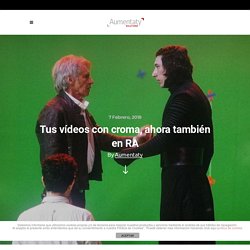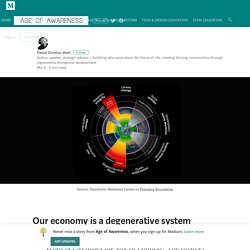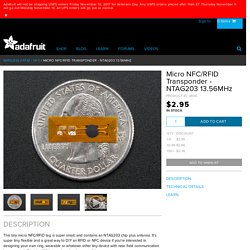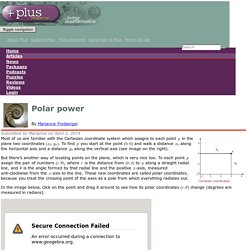

Tus videos con croma (pantalla verde) ahora también en RA. Creator es la parte de la plataforma Aumentaty que sirve para crear escenas en realidad aumentada.

Con la última actualización, hemos incorporado algunas novedades. Éstas harán que tus contenidos puedan brillar mucho más. Aunque todavía es una versión Beta, poco a poco la plataforma va tomando forma. Esta versión de Creator (y su correspondiente versión en Scope) permite hacer cosas en realidad aumentada que harán que tus proyectos sean aún más vistosos. Por ejemplo, ¿te imaginas crear un vídeo en croma? No dejes de probar y compartir tus proyectos con nosotros! Aumentaty Creator v1.3.3 Beta Mejoras y arreglos de fallos: •Nuevo: se puede cargar nuevos modelos 3d: gltf, ply y stl. Building capacity for systemic transformation to help realise the SDGs.
Introducing the SDG Training of Multipliers, the SDG Flashcards and the SDG Canvas. In December 2016 — a little over a year after the launch of the United Nations’ ‘Sustainable Development Goals’ (SDGs) and ‘Agenda 2030’ — Gaia Education launched a day-long workshop format supported by a facilitation tool called the ‘SDG Implementation Flashcards.’

The ‘Training of Multipliers’ and the flashcards aim to promote cross-sectorial civic participation in the implementation of the SDGs at local, (bio)regional and sub-national scale. Defining my own design brief for a tool and process to spread conversations aimed at locally meaningful SDG implementation In my role as ‘Head of Design & Innovation’ for Gaia Education, I was asked to develop a new one-day training to promote SDG implementation at the scale of communities, organizations and businesses. The first thing that came to mind was an inspirational Buckminster Fuller quote: “If you want to teach people a new way of thinking, don’t bother trying to teach them.
. — R. The Multipliers Handbook The SDG Project Canvas. Our economy is a degenerative system – Age of Awareness. “What is 120 times the size of London?

The answer: the land or ecological footprint required to supply London’s needs.” — Herbert Giradet Our ecological footprint exceeds the Earth’s capacity to regenerate. A number of useful indicators and frameworks have been developed to measure the ecological impact that humanity and its dominant economic system with its patterns of production, consumption and waste-disposal are having on the planet and its ecosystems. The measure and methodology for ecological footprinting translates the resource use and the generation of waste of a given population (eg: community, city, or nation) into the common denominator of bio-productive land per person, measured in Global Hectares (Gha), that are needed to provide these resources and absorb those wastes.
2D supercapacitor design and laser created graphene. More Good News About The 'Scientific Accident That May Change The World' Graphene supercapacitors | Photo: UCLA That battery life video that had gone viral due to a recent post on UpWorthy (and which we told you about Tuesday) now has an update.

We told you that researchers at Ric Kaner's lab at UCLA had found a way to make a non-toxic, highly efficient energy storage medium out of pure carbon using absurdly simple technology. Today, we can report that the same team may well have found a way to make that process scale up to mass-production levels. The recap: Graphene, a very simple carbon polymer, can be used as the basic component of a "supercapacitor" -- an electrical power storage device that charges far more rapidly than chemical batteries. Split-ring resonator - negative index of refraction (meta-)materials. Split-ring resonator consisting of an inner square with a split on one side embedded in an outer square with a split on the other side.

Split-ring resonators are on the front and right surfaces of the square grid, and single vertical wires are on the back and left surfaces.[1][2] Electric field (top) and magnetic field (bottom) of an electric-SRR under resonant electrical excitation. The magnetic response arises from the symmetry of the current loops. Micro NFC/RFID Transponder - NTAG203 13.56MHz ID: 2800 - $2.95. This tiny micro NFC/RFID tag is super small, and contains an NTAG203 chip plus antenna.

It's super tiny, flexible and a great way to DIY an RFID or NFC device if you're interested in designing your own ring, wearable or whatever other tiny device with near field communication incorporated. Contains 144 bytes of read-write accessible memory.You can use this with our PN532-based RFID reader breakouts & shields, and will work with all the latest cellphones or tablets that have NFC built in. Note that since the antenna is so small you'll need to put the tag right up against the device that's reading it.
Can be used to control a cellphone with commands, URLs, unlocking, etc.Learn more about RFID / NFC products and projects on the Adafruit Learning System. Micro Spiral PCB Teslacoil. Polar power. Cartesian coordinates.

Most of us are familiar with the Cartesian coordinate system which assigns to each point in the plane two coordinates . To find. Dual Spiral. Graphene Electromagnet. Micro Spiral PCB Teslacoil. Micro Spiral PCB Teslacoil.